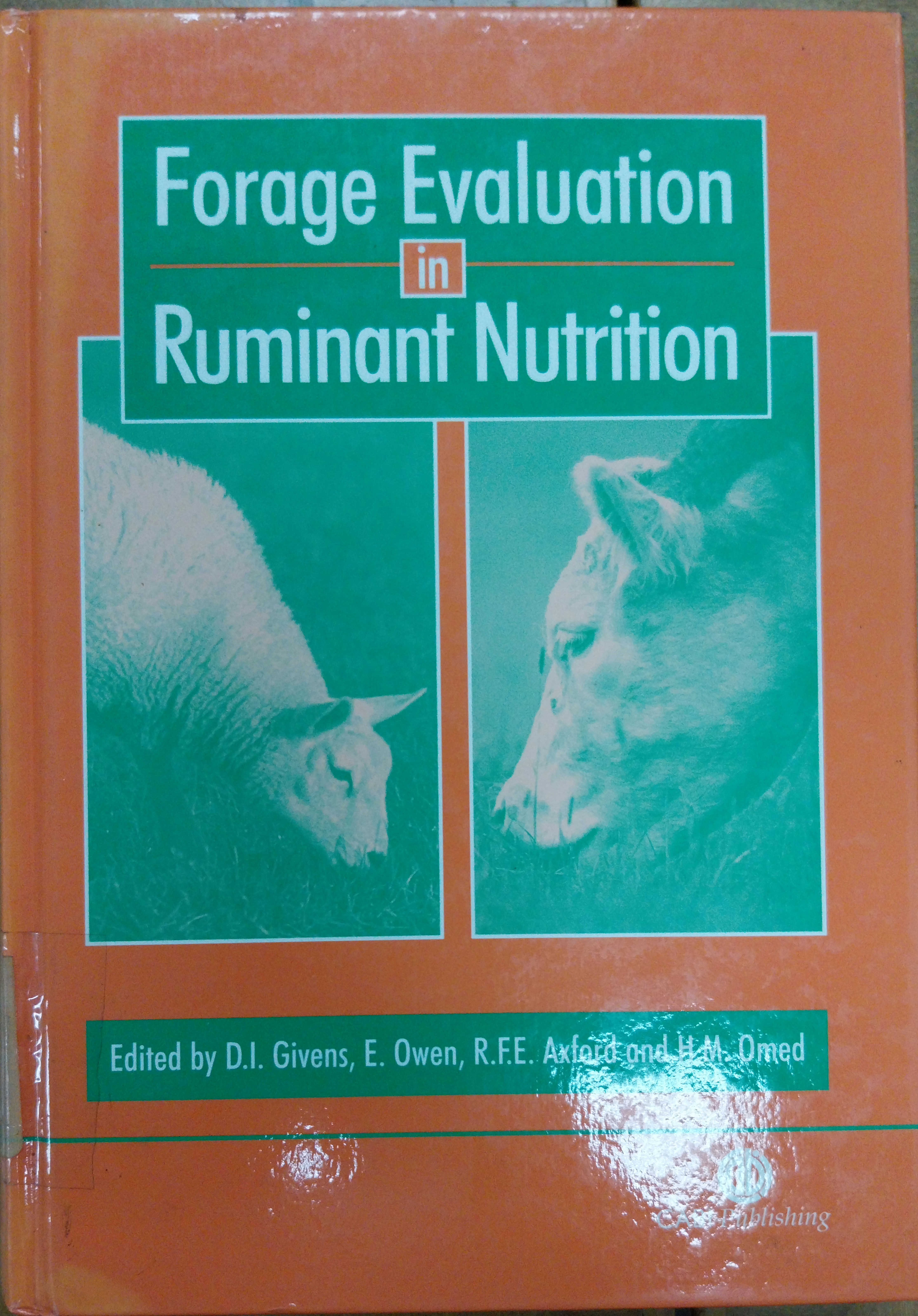
| Judul | Forage Evaluation in Ruminant Nutrition / CAB International |
| Pengarang | D.I. Givens E. Owen R.F.E. Axford H.M. Omed |
| Penerbitan | New York : CABI Publishing, 2000 |
| Deskripsi Fisik | 480 hlm ;27 cm |
| ISBN | 0-85199-344-3 |
| Subjek | Forage Evaluation in Ruminant Nutrition Rak Koleksi Referensi |
| Abstrak | Over 3000 million hectares of the land area of the earth (over 25%) is grazing land and another 4000 million hectares of forest and woodland have some grazing potential. World grasslands support approximately 1500 million cattle equivalents (cattle, buffalo, sheep, goats and camels) and forages provide over 90% of the feed energy consumed by these herbivorous animals. The world's forages therefore indi- rectly provide a very high proportion of the food for its population. This is achieved without seriously reducing the quantity of food available for direct human consumption. Although forages generally provide nutrients to animals at lower cost than concentrate feeds, they are inherently variable in nutritive value. This depends on many factors such as forage species, climate, degree of maturity, etc. In many parts of the world, forages are conserved by processes such sun curing and ensiling. These processes can fundamentally change the nutritional characteristics of the original forage, sometimes in unpred |
| Bahasa | Inggris |
| Bentuk Karya | Bukan fiksi atau tidak didefinisikan |
| Target Pembaca | Umum |
| No Barcode | No. Panggil | Akses | Lokasi | Ketersediaan |
|---|---|---|---|---|
| 00000001064 | 633.3 D.I f | Dapat dipinjam | Perpustakaan BSIP Jakarta - Ruang Baca Umum | Tersedia |
| Tag | Ind1 | Ind2 | Isi |
| 001 | INLIS000000000000987 | ||
| 005 | 20240731013926 | ||
| 007 | ta | ||
| 008 | 240731################g##########0#eng## | ||
| 020 | # | # | $a 0-85199-344-3 |
| 035 | # | # | $a 0010-0124000716 |
| 082 | # | # | $a 633.3 |
| 084 | # | # | $a 633.3 D.I f |
| 100 | 1 | # | $a D.I. Givens |
| 245 | 1 | # | $a Forage Evaluation in Ruminant Nutrition /$c CAB International |
| 260 | # | # | $a New York :$b CABI Publishing,$c 2000 |
| 300 | # | # | $a 480 hlm ; $c 27 cm |
| 520 | # | # | $a Over 3000 million hectares of the land area of the earth (over 25%) is grazing land and another 4000 million hectares of forest and woodland have some grazing potential. World grasslands support approximately 1500 million cattle equivalents (cattle, buffalo, sheep, goats and camels) and forages provide over 90% of the feed energy consumed by these herbivorous animals. The world's forages therefore indi- rectly provide a very high proportion of the food for its population. This is achieved without seriously reducing the quantity of food available for direct human consumption. Although forages generally provide nutrients to animals at lower cost than concentrate feeds, they are inherently variable in nutritive value. This depends on many factors such as forage species, climate, degree of maturity, etc. In many parts of the world, forages are conserved by processes such sun curing and ensiling. These processes can fundamentally change the nutritional characteristics of the original forage, sometimes in unpredictable ways. Given the importance and variability of forages, it is vital that methods exist that can reliably assess their key nutritional attributes including, crucially, their voluntary intake by animals. In recent years a number of important factors have come into play that are changing the ways in which forage characterization in the laboratory is approached. For instance, in some countries characterization of rumi- nant feeds in general is rapidly moving away from expressions of energy and protein content to an assessment of the nutrients supplied to the animal both directly and indirectly as a result of microbial activity in the rumen. In addition, in some places there is increasingly powerful public pressure to reduce or stop the use of surgically modified animals in nutritional studies. This may rapidly reduce the use of tech- niques reliant on rumen fluid and alternatives to these will have to be found. There has been a tremendous upsurge in the use of near infrared reflectance spectroscopy for forage characterization in countries where the expensive technology is avail able. This emphasizes the need for cheaper but still reliable methods for less well- equipped regions of the world. |
| 650 | # | 4 | $a Forage Evaluation in Ruminant Nutrition |
| 650 | # | 4 | $a Rak Koleksi Referensi |
| 700 | 1 | # | $a E. Owen |
| 700 | 1 | # | $a H.M. Omed |
| 700 | 1 | # | $a R.F.E. Axford |
| 990 | # | # | $a 00000001064 |
Content Unduh katalog
Karya Terkait :